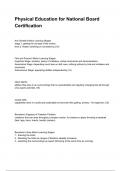Physical Education for National Board
Certification
Ann Gentile's Motor Learning Stages
stage 1: getting the concept of the motion
level 2: fixation (working on consistency) (15)
Fitts and Posner's Motor Learning Stages
Cognitive Stage: amateur, plenty of mistakes, verbal commands and demonstrations
Associative Stage: depending much less on skill cues, refining actions by trial and mistakes and
comments
Autonomous Stage: appearing abilties independently (15)
Open talents
abilties that arise in an surroundings that is unpredictable and regularly changing like all through
crew sports activities (15)
closed skills
capabilities done in a solid and predictable environment like golfing, archery - for beginners (15)
Bernstein's Degrees of Freedom Problem
variations that can arise throughout complex motion, for instance a glass throwing a baseball
(feet, legs, torso, hands, hands) (sixteen)
Bernstein's three Motor Learning Stages
1 - freezing the limbs
2 - liberating the limbs as ranges of freedom steadily increases
3 - exploiting the surroundings as expert (throwing at the same time as running)
,Motor Learning
Integration of motor control approaches via exercise and enjoy, leading to a pretty everlasting
exchange inside the ability to provide professional moves. (16)
Motor Performance
demonstration of a ability or set of competencies, now not permanent (sixteen)
Knowledge of Performance
the first-class of performance, felt through learner at some stage in motion or determined at the
same time as watching movement (16)
Prescriptive Feedback
Provides hints to accurate the error (17)
Terminal Feedback or Knowledge of Results
the final results feedback after the skill has been done (17)
Skill switch
1.
2.
3.
Nice = previously found out ability benefits every other ability
poor = formerly found out ability impedes new skill
zero = formerly found out no effect on new ability (17)
five Tenets of Deliberate Practice
1. Exercise is essential
2. Frequency of exercise wishes to be excessive
3. Quick period but high first-class
4. Set up dreams and goals
,5. Direct early comments wishes to accept (17)
Feedback for Motor Skills
wellknown = vague
specific = on ability action
positive = praise
negative = what is incorrect
constructive = both positive and poor (17)
3 Step Sandwich Method of remarks
1. What you probably did nicely
2. What is inaccurate and why or how it impedes mastery
three. Specific cues on how to correctly perform ability (18)
Fleishman's Taxonomy of Motor Abilities (Perceptual)
sensory motor elements of how the frame interprets and responds to surroundings - reaction
time, fee control, aiming, manual and finger dexterity, control precision, arm-hand steadiness
(18)
Fleishman's Taxonomy of Motor Abilities (Physical)
consists of talent related and fitness associated - muscular strength, muscular patience,
flexibility, cardiovascular patience, coordination, strength, velocity, balance (18)
Perceptual Motor Development
genetic, evolved in degrees and practice, auditory discrimination = ability to distinguish between
sounds, visible discrimination = images, kinesthetic discrimination = small changes in muscle
motion, missing this type of makes it greater tough to broaden perceptual motor capabilities (18)
vision
aids in stability and coordination, information also travels to muscle tissues and inner ear, eye
monitoring, movement precision, reaction time, peripheral vision (19)
, hearing
influences perceptual motor talents too, response time, sound indicators or prepares body for a
response, using auditory cues helps verbal cues and tactile getting to know (19)
Kinesthetic machine
The sensory device that monitors the positions of the diverse components of 1's frame, entails
joints, muscle tissue, tendons, receptors in skin ears eyes (19)
Individual constraints
can be structural constraints like height, weight, gender or functional constraints like
psychological and IQ (19)
Task constraints
motion goals, recreation policies, equipment, ball length (19)
Environmental constraints
bodily environment like space, lighting fixtures, temperature, climate and sociocultural
surroundings like gender, ethnicity, social class, beliefs (19)
Albert Bandura: Social Learning Theory
Imitation fashions. Learning happens via commentary and imitation of fashions; as youngsters
end up older, they emerge as more selective in the behaviors they imitate - modeling,
reinforcement, social evaluation - because we will have a look at anywhere 1. Interest 2.
Retention three. Motor replica four. Motivation (19)
Emotional Development
ought to manipulate feelings to recognition on instruction, self confidence the way you feel about
yourself and self efficacy = the belief in your ability to carry out motor abilities (20)




